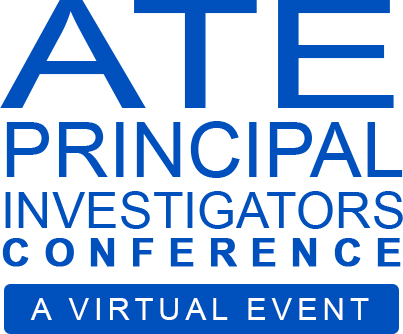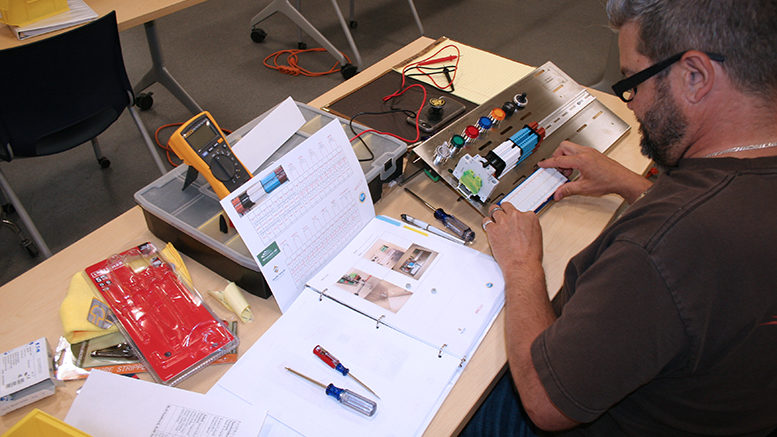Mechatronics instructors from four two-year colleges reported at the 2021 ATE Principal Investigators’ Conference that dual enrollment is a powerful tool for building their enrollments and addressing employers’ needs for skilled technicians.

All four of the colleges have received Advanced Technological Education grants from the National Science Foundation to test faculty-driven innovations for mechantronics education. Mechatronics programs teach a combination of electronics, mechanics, pneumatics, hydraulics and computer control systems.
Andrew Robertson, coordinator of workforce development at Gadsden State Community College, said the ATE grant “helped us tremendously.”
This fall, the Alabama college has 30 high school students on campus for a new degree program that combines mechatronics, robotics and automation technologies. It aims to develop cross-trained technicians. Four auto manufacturers – Mercedes, Honda, Toyota-Mazda and Hyundai – have enormous facilities near Gadsden that have high needs for technicians with advanced skills in multiple manufacturing technologies.
The new program allows teens to enroll beginning with sophomore year of high school. It also lowered the grade point average (GPA) threshold from 2.5 to 2.0 to include hands-on learners who struggle with traditional high school classes.
Yielding positive results
Robertson said a recent longitudinal study of Gadsden’s established dual-enrollment program found that high school graduates who were dual-enrollment students earn postsecondary credentials at a much higher rate than their peers.
The study looked at educational outcomes six years after high school graduation. It found that when students “successfully complete four dual-enrollment courses, it tripled the percentage of students that wound up going on to receive either an associate degree, certificate or bachelor’s or master’s degree. So, if you start them early in the dual enrollment, it’s a huge benefit … it triples that amount of students who complete their degrees or essentially get something, which then improves your workforce,” Robertson said.
Douglas C. Brauer, dean of engineering and industry at Florida State College at Jacksonville (FSCJ), shared information about the Early College Academy of Advanced Manufacturing and Engineering at Englewood High School. It is sponsored by Johnson & Johnson Vision Care, Inc., which provides paid summer internships for the students. Students must have a 3.0 GPA to be considered for the selective program.
“Eighty [junior and senior] students throughout the year come to the FSCJ downtown campus Advanced Technology Center (ATC) to take the courses led by FSCJ faculty,” Brauer explained.
The students move in cohorts through the “laboratory-intensive” engineering and industry programs.
This experience and the associate of science degree the students earn along with their high school diploma “opens them up to a lot of possibilities,” Brauer said. Academy graduates have “priority interview status” with Johnson & Johnson. However, with so many high-tech manufacturers in the region, the students “are seeing all the companies looking to hire people with these mechatronics skills…. The program is really exposing the students to what are the opportunities that are very real in high-paying careers in the automation technologies.”
This experience and the associate of science degree the students earn along with their high school diploma “opens them up to a lot of possibilities,” Brauer said. Academy graduates have “priority interview status” with Johnson & Johnson. However, with so many high-tech manufacturers in the region, the students “are seeing all the companies looking to hire people with these mechatronics skills…. The program is really exposing the students to what are the opportunities that are very real in high-paying careers in the automation technologies.”
High demand across the country
Industry demand for technicians with mechatronics skills is high in rural Minnesota and Nebraska, too. This year, South Central College in Minnesota with Central Community College in Nebraska launched the Independent Mechatronics Education Curriculum 2.0 at 10 high schools, five in each state, to respond to that need.
Everyone involved is happily surprised by the enrollment of 180 students this fall. Approximately 100 students had been expected to enroll.
“The biggest impact that we are seeing – and that industry is so pleased with – is that it is exposing 180 kids to mechatronics that never had the opportunity before. So they see it as a way to build the pipeline of technicians that are going in our programs,” said Doug Pauley, associate dean of training and development at the Columbus Campus of Central Community College.
‘Instructor in the Loop’
The project expands the use of the independent Remote Experiment Automation Lab (iREAL) trainers, which the project’s Principal Investigator Doug Laven developed with a previous ATE grant. Laven is the director of the Mechatronics Technology Education Center at South Central, where he also teaches.
The new project uses what Laven and Pauley call an “Instructor in the Loop” format to teach four mechatronics courses for college credit.
The high school STEM teachers, who have little or no background in mechatronics, learn about mechatronics and the pedagogy for incorporating the iREAL trainers and online content during intense professional development summer workshops taught by the community college faculty.
The high school teachers serve as facilitators in high school classrooms where students do lab exercises on the iREAL trainers and view online modules and short White Glove Videos created by community college faculty who are the “instructors of record.” During the academic year the college instructors stay in touch with the high school teachers via phone and email.
Laven said the facilitators have been sending lots of student questions to the instructors-of-record. The questions and answers are shared with all the facilitators to add to everyone’s understanding. But, he said, “Each school can work at a different pace, which also adds to the uniqueness of our projects.”
Laven is optimistic about the program’s outcomes: “I really think this model could be a new norm for dual enrollment. I really believe that our Mankato (Minnesota) campus mechatronics program will get most of its students from high schools from this program. It really is a win-win for both the student and college. The student can receive up to 12 credits and the college can enroll them into their programs and place them in industry with well-paying rewarding careers.”

